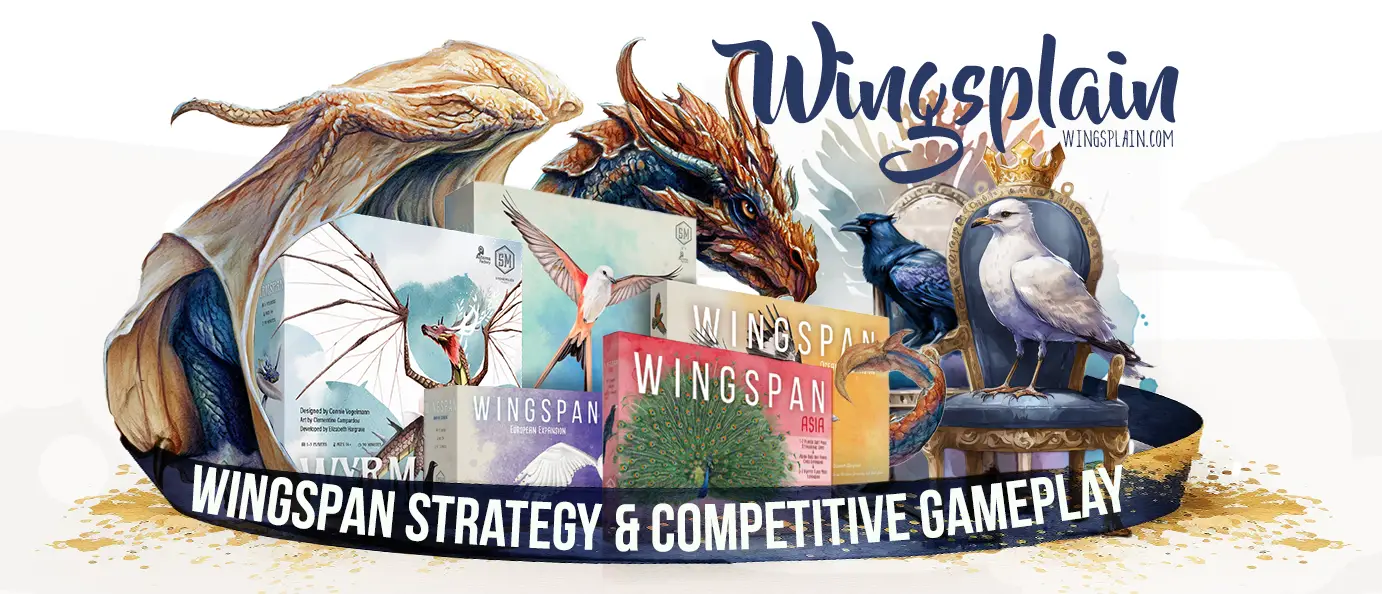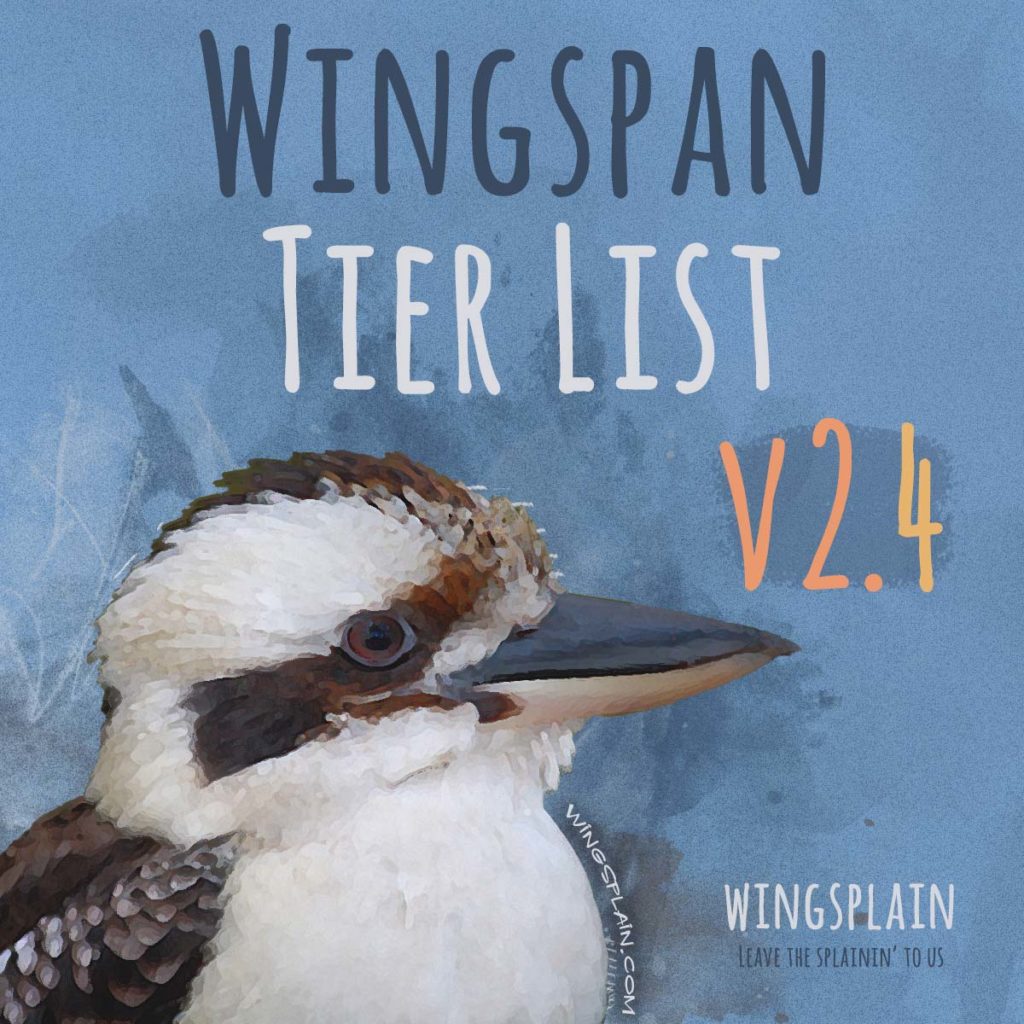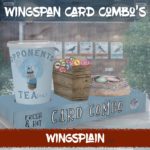Wingspan Bird Card Tier List Update
In this update, my ranking philosophy changes from an Oceania Expansion (OE) focus to a non-Oceania Expansion focus. When the Oceania Expansion released, I focused on that metagame because it was the new and exciting thing, and in my home games, it became “default Wingspan.”
It occurs to me now that during Wingspan’s entire life cycle, there will be far more games played on the core set play mats than there will be on the OE play mats. OE will be the exception, not the rule.
As a result, I’m removing the “Oceania board penalty” that I was applying to my rankings of cheap food-producing birds and Tuck/Draw birds that are playable in the Grasslands. This should result in a Tier list that is much more relatable to the wider Wingspan audience of the future.
- Cheap food-producing birds are important early game accelerators in any game using the Core Set boards.
- Tuck/Draw birds are the backbone of many point-scoring engines. Card cycling is an important element of any winning strategy, and stacking this effect in the Grasslands is incredibly potent when adequately supported with excess cards in hand.
- Cheap food caching birds are an essential element of strengthening any Forest strategy. They serve as the backbone of the most potent forest engines.
Bonelli’s Eagle: T0 to God Tier: Easy to play, game warping, point bomb. Improves the value of PABs, especially Teal and Yellow. https://wingsplain.com/what-makes-a-top-tier-bird-card-in-wingspan/
Eastern Imperial Eagle: T0 to God Tier: Easy to play, game warping, point bomb. Improves the value of PABs, especially Teal and Yellow. https://wingsplain.com/what-makes-a-top-tier-bird-card-in-wingspan/
Spangled Drongo: T1 to T0: “If there is an S-Tier pink power bird, Spangled Drongo (SP) is probably it. In a four to five-player game using Oceania Expansion rules, SP is a hard counter to many nectar gaining birds such as Hummingbirds, Silvereye, Lewin’s Honeyeater, Eastern Rosella, Sulphur-Crested Cockatoo, Common Nightingale, and Bluethroat, which will all “give” an SP player two nectar to their one. That’s Raven-level food.” https://wingsplain.com/what-makes-a-top-tier-bird-card-in-wingspan/
Mute Swan: T1 to T0: Mute Swan has proven to be one of the premier birds and win conditions of the European Expansion. This mass tucker recycles up to three dud cards (as long as you have three birds in your wetlands) and reimburses you one card, 33% of the cards tucked.
This is even more striking when backed up by a repeater bird, as the Swan then easily outperforms a full power Common Chiffchaff. By comparison, the Chiffchaff has a harder time taking advantage of repeater birds due to the tremendous card volume required, and it doesn’t reimburse cards.
Bushtit: T2 to T1: Classic poster child for the Tuck/Lay archetype. A great compliment to Chiffchaff engines. https://wingsplain.com/wingspan-the-power-of-tucking-cards/#TuckLay_Cards
Common Grackle: T2 to T1: See Bushtit.
Great Crested Grebe: T2 to T1: This bird’s power has proven to be very good at generating early game card advantage. The two fish cost isn’t that hard to deal with in the early game. Two egg star nest is small but welcome. It’s easy to get onto the board from your opening hand with starting nectar (Oceania Expansion Rules). https://wingsplain.com/combating-the-power-4-birds-in-wingspan-wingsplain-1/#4_Dig_for_High_Impact_Cards
Red-Legged Partridge: T2 to T1: The Definition of Egg Spam. A good drop for column 1 on the OE board to boost egg production. Easy to group up with birds in the first column.
Triple seed cost holds it back a bit, but this is less of a problem with the starting nectar of OE. This can contribute to a massive Grasslands point scoring engine if properly supported.
Peaceful Dove: T2 to T1: A cheap way to lay eggs in the Forest. A Forest engine shouldn’t have trouble producing the required seeds.
Common Chaffinch: T2 to T1: Despite not being able to play it in the Wetlands, Common Chaffinch has proven to be a decent mid to late game pivot, converting excess cards into points. This is incredibly potent in a Grasslands engine where you are also stacking points from eggs.
It also happens to be a food-efficient play at 4 points for the cost of a single food, and it picks up two more points from Bird Counter.
Barn Swallow: T2 to T1: Classic, cheap Tuck/Draw bird with the flexibility of living in Grasslands or Wetlands.
Blue Grey Gnatcatcher: T2 to T1: Good early game food accelerator. Less impactful on OE mat.
House Finch: T2 to T1: Classic Tuck/Draw bird with a large nest and versatility of habitats.
Painted Whitestart: T2 to T1: Good early game food accelerator. Less impactful on OE mat.
Purple Martin: T2 to T1: Classic, cheap Tuck/Draw bird with the flexibility of living in Grasslands or Wetlands.
Ruff: T1 to T0: Ruff has demonstrated that it can be a massive point scoring engine if you keep three cards in your hand throughout the game. It’s easy to play and can wind up being a 13-point bird by game end. Cycling 12 cards over four rounds is a huge card advantage.
Common Cuckoo: UUT to T1: This bird has proven to be a very flexible/useful passive egg-laying bird thanks to laying eggs in both cup nests and ground nests. It’s great passive support for Mute Swan and Common Chiffchaff. Food Web Expert makes it a solid play in general.
Black Headed Gull: UUT to T1: Black Headed Gull is a good option to produce food in the wetlands and harass your opponent simultaneously. It’s a standout among the other “stealing birds” in that you can use the food you steal instead of being forced to cache it. This can be less effective in the OE metagame since your opponent can return to the birdfeeder for nectar.
White-Throated Swift: UUT to T1: A solid point scoring option that has more impact on the core set play mat.
American Robin: UUT to T1: A solid point scoring option that has more impact on the core set play mat. Strong in the Grasslands.
Pheasant Coucal: UUT to T1: Doesn’t need another bird with a specific nest type to lay eggs on. A sizeable four egg nest of its own gives you time to spend eggs.
Indigo Bunting: UUT to T1: Expensive, but having three different food types make it easier to play from your starting hand. A good way to generate food in the Grasslands, especially on the core set mats. Solid five points.
Red-Breasted Nuthatch: UUT to T1: It’s a staple point-scoring element of Forest engines in the Core meta.
White Breasted Nuthatch: UUT to T1: It’s a staple point-scoring element of Forest engines in the Core meta.
Mountain Chickadee: UUT to T1: It’s a staple point-scoring element of Forest engines in the Core meta.
Carolina Chickadee: UUT to T1: It’s a staple point-scoring element of Forest engines in the Core meta.
Dark-Eyed Junco: UUT to T2: A solid point scoring, food-producing option that has more impact on the core set play mat and in the absence of nectar. Strong in the Grasslands.
Cedar Waxwing: UUT to T2: See Dark-Eyed Junco.
Bronzed Cowbird: UUT to T2: A solid, passive egg layer. Moderate cost and point value.
Brewer’s Blackbird: UUT to T2: A solid point scoring option that has more impact on the core set play mat.
Western Tanager: UUT to T2: Expensive, and having two worms in its cost makes it harder to play from your starting hand without nectar. A solid food-producing bird with a good point value.
Rose-Breasted Grosbeak: UUT to T2: Expensive, but having three different food types make it easier to play from your starting hand. A solid food-producing bird with a good point value.
European Robin: UUT to T2: An expensive yet solid food-producing bird that is easy to drop from the opening hand due to its diverse food cost.
Eurasian Golden Oriole: UUT to T2: This can be solid passive food generation for strategies without a strong Forest presence. Star Nest is nice.
Hooded Crow: UUT to T2: See Ruff. Hooded Crow is a weaker version.
Eurasian Magpie: UUT to T2: Grasslands engines are the strongest point-scoring engines on the core set play mat, and this bird capitalizes on it. Free caching from the general supply is ideal. Combos with Coal Tit and Eurasian Nuthatch, who can spend cached seeds.
Regent Bowerbird: UUT to T2: Flexible and cheap. It only gives a worm to a single opponent.
Wilson’s Storm Petrel: UUT to T2: See Great Crested Grebe. This bird is a bit of a contradiction. It’s expensive and difficult to get on the board in the early game, but that’s when its power is the most useful.
It has a puny one egg nest, but at least it’s a star nest. It’s easier to get onto the board early with starting nectar (Oceania Expansion Rules). https://wingsplain.com/combating-the-power-4-birds-in-wingspan-wingsplain-1/#4_Dig_for_High_Impact_Cards
Black Swan: UUT to T2: “The Black Swan card is a strong point bomb if you have Omnivore Specialist. It becomes even better if you have a couple of qualifying birds with wingspans over 100cm. The Black Swan fits right in with a predator-heavy game where many of these birds have larger wingspans (and are usually worth more points in general).
It also plays well with the flightless birds introduced in Oceania since they have wild wingspans.” https://wingsplain.com/wingspan-yellow-powers-ranked/
Long Tailed Tit: UUT to T2: In the absence of a traditionally effective, cheap food generating bird, LTT has proven to be a suitable replacement to accelerate your Forest in the opening turns of the game. Ignoring the egg cost of the 2nd column is the key feature of this bird’s acceleration potential, as it allows you to ignore that first Lay Eggs action. A four-egg star nest bolsters its utility.
Grey Heron: UUT to T2: In the absence of a traditionally effective, cheap card drawing bird, Grey Heron has proven to be a suitable replacement to accelerate your Wetlands in the opening turns of the game. Ignoring the egg cost of the 2nd column is the key feature of this bird’s acceleration potential, allowing you to ignore that first Lay Eggs action.
Its two fish cost is a drag and hurts its potential, but this is less of a problem with Oceania rules since you start with one free nectar.
Dunnock: UUT to T2: Dunnock has proven to be a circumstantial yet acceptable egg layer in the EE metagame.
Eurasian Nuthatch: UUT to T2: It’s a staple point-scoring element of Forest engines in the EE meta.
Juniper Titmouse: UUT to T2: It’s a staple point-scoring element of Forest engines in the Core meta.



